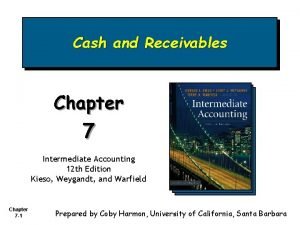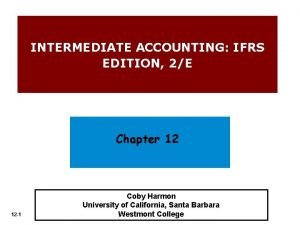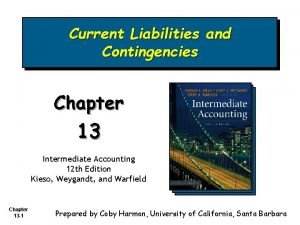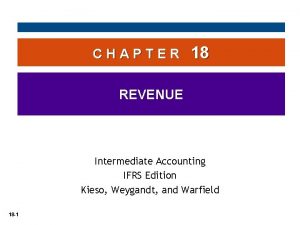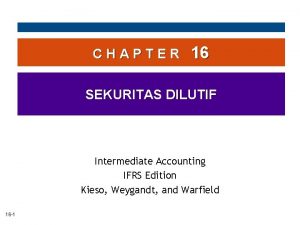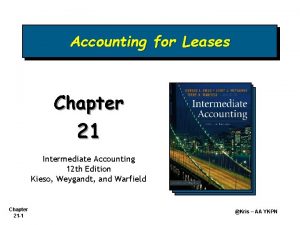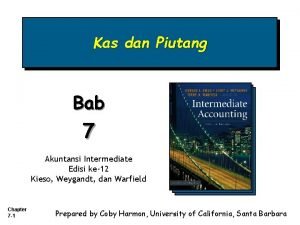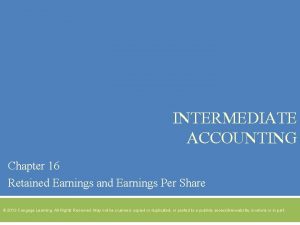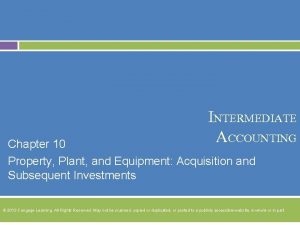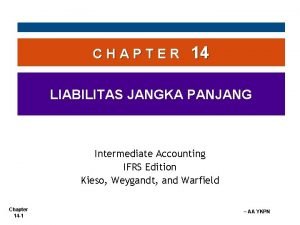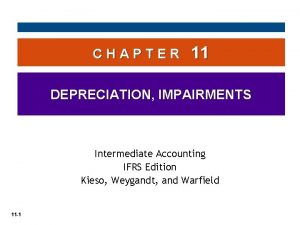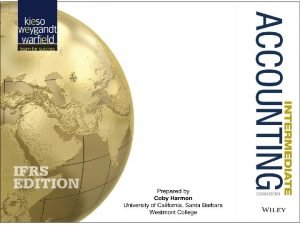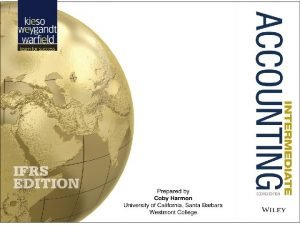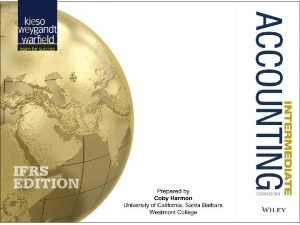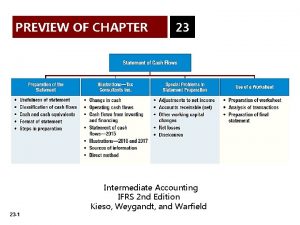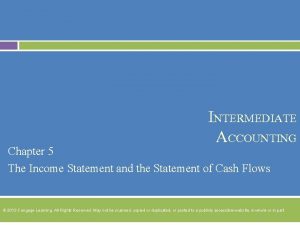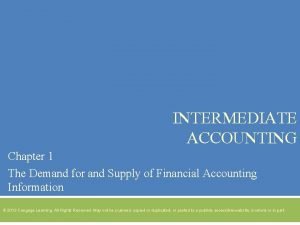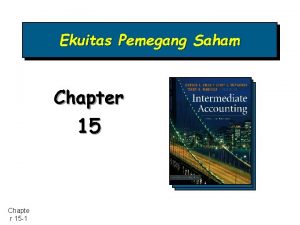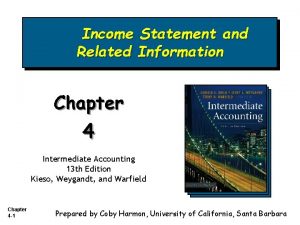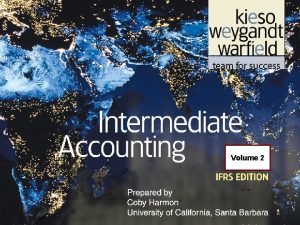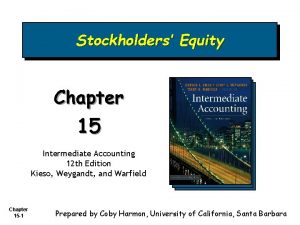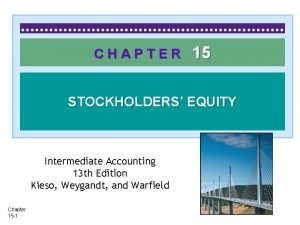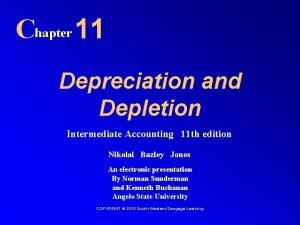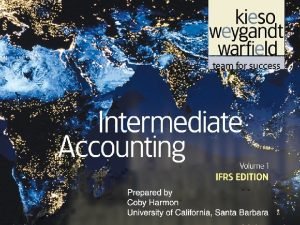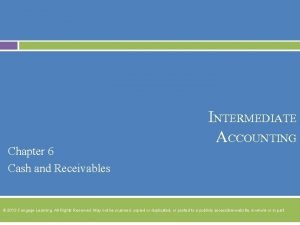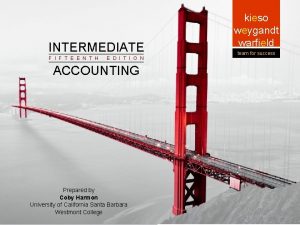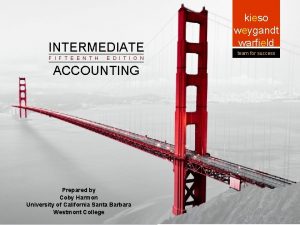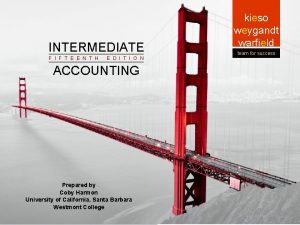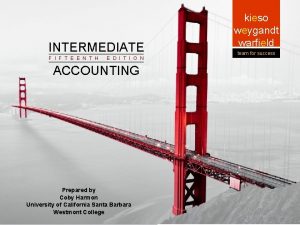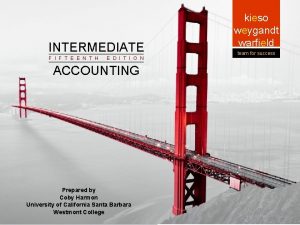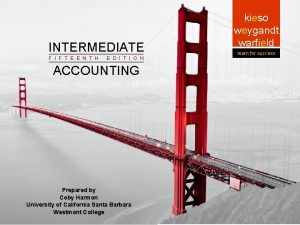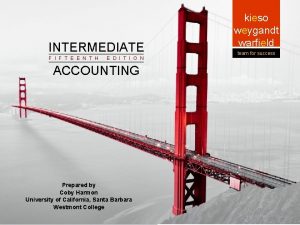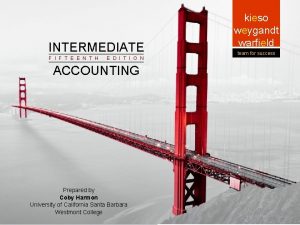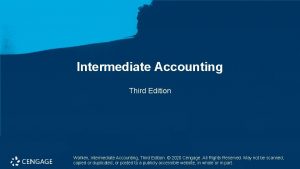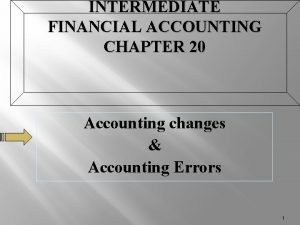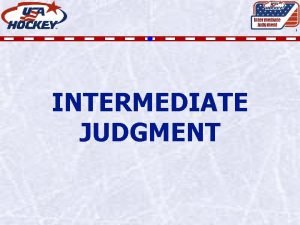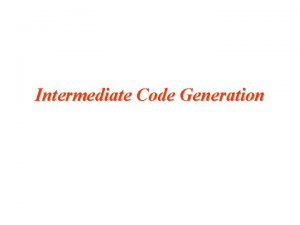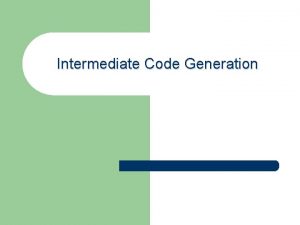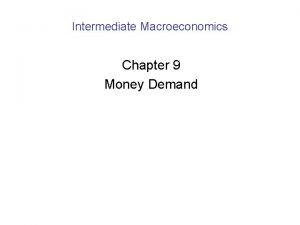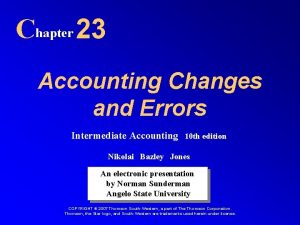INTERMEDIATE ACCOUNTING Chapter 1 The Demand for and



































- Slides: 35

INTERMEDIATE ACCOUNTING Chapter 1 The Demand for and Supply of Financial Accounting Information © 2013 Cengage Learning. All Rights Reserved. May not be scanned, copied or duplicated, or posted to a publicly accessible website, in whole or in part.

Objectives 1. 2. 3. 4. 5. 6. 7. Understand the forces that create the demand for financial accounting information in the world economy. Understand the forces that determine the supply of accounting information, particularly the role of the Securities and Exchange Commission (SEC). Explain the role of the Financial Accounting Standards Board (FASB) for establishing U. S. generally accepted accounting principles (GAAP). Explain and use the FASB Accounting Standards Codification system. Explain the role of the International Accounting Standards Board (IASB) in establishing International Financial Reporting Standards (IFRS) and the ongoing convergence of accounting standards between the FASB and the IASB. Understand the output of the financial reporting process and the four primary financial statements, as well as the important information reported with financial statements. Understand that, because financial accounting information triggers important economic consequences, ethics and the ability to resolve ethical dilemmas are essential to the accounting profession. © 2013 Cengage Learning. All Rights Reserved. May not be scanned, copied or duplicated, or posted to a publicly accessible website, in whole or in part.

The Need Financial Accounting Information Forces that create demand Companies compete for a wide variety of resources such as financial capital, physical and natural resources, intellectual property and technology, new product and service ideas, skilled employees and executives, customers, and suppliers. � Strategies Companies need to develop a business plan with strategic goals and specific tactics. � This business model should be different from that of its rivals, utilizing whatever competitive advantages it might have. © 2013 Cengage Learning. All Rights Reserved. May not be scanned, copied or duplicated, or posted to a publicly accessible website, in whole or in part.

Business Activities Financing Activities � � Investing Activities � Involve raising equity capital by attracting investments from business owners, such as common shareholders Can be acquired from lenders or by the issuance of bonds Using of the financial capital to acquire productive resources such as property, plant, equipment, technology, intellectual property, legal rights and operating agreements necessary to operate the business Operating Activities � Utilizing resources in day-to-day activities to produce © 2013 Cengage Learning. All Rights Reserved. May not be scanned, copied or duplicated, or posted to a publicly accessible website, in whole or in part.

Who Are the Stakeholders? Stakeholders are those who have an interest in a company. Examples of stakeholders � � � � Common equity shareholders Banks Creditors Managers and employees Suppliers Customers Governmental authorities Local communities © 2013 Cengage Learning. All Rights Reserved. May not be scanned, copied or duplicated, or posted to a publicly accessible website, in whole or in part.

What Do Stakeholders Need to Know? Investors � � � The business model, strategies, and competitive advantages of the company. Resources the company owns and the debt it owes. The net income or net loss, cash flows, and whether profits and cash flows are growing over time. Creditors � � � The amount of equity capital in place. Resources the company owns and the debt it owes. Cash flows to determine the company’s ability to © 2013 Cengage Learning. All Rights Reserved. May not be scanned, copied or duplicated, or posted to a publicly accessible website, in whole or in part.

What Drives Stakeholders’ Demand for Accounting Information? Stakeholders need to have financial information available to make informed decisions about resource allocations. The financial reporting process must communicate financial accounting information to users. Information must be relevant and reliable so that they can make resource allocation decisions. © 2013 Cengage Learning. All Rights Reserved. May not be scanned, copied or duplicated, or posted to a publicly accessible website, in whole or in part.

The Separation of Ownership and Control (Slide 1 of 2) Common shareholders and creditors provide financial resources by investing in and lending to the company. The company executives, managers, and employees have been hired to invest those financial resources and conduct the daily operations on behalf of the investors and creditors. Problems can arise because of the separation of ownership and control. The investors and creditors who provided financial capital own the resources but are separate from the executives, managers, and employees who have day-to-day control of those resources. © 2013 Cengage Learning. All Rights Reserved. May not be scanned, copied or duplicated, or posted to a publicly accessible website, in whole or in part.

The Separation of Ownership and Control (Slide 2 of 2) © 2013 Cengage Learning. All Rights Reserved. May not be scanned, copied or duplicated, or posted to a publicly accessible website, in whole or in part.

What Drives the Demand for Accounting Standards and Independent Audits? A natural demand arises for accounting standards that managers can use to measure and report financial statements that are relevant and representationally faithful. Professional standards, such as Generally Accepted Accounting Principles (GAAP) in the U. S. and International Financial Reporting Standards (IFRS) are not sufficient to meet users’ demands. � � Accounting standards require many choices, judgments, and estimates. This gives rise to a demand for independent audits. Auditors are typically external, independent experts in accounting who carefully evaluate a company’s accounting records and verify whether the company has applied the accounting standards and principles fairly and consistently. What do auditors provide? © 2013 Cengage Learning. All Rights Reserved. May not be scanned, copied or duplicated, or posted to a publicly accessible website, in whole or in part. �

The Supply of Financial Accounting Information The supply of accounting information that companies report is determined primarily by the interactions between two main forces: � � Authoritative professional accounting standards, such as U. S. GAAP or IFRS, that govern in the company’s country of incorporation. Choices, methods, estimates, and judgments that the company must make in order to apply those accounting standards to measure and report their financial statements. © 2013 Cengage Learning. All Rights Reserved. May not be scanned, copied or duplicated, or posted to a publicly accessible website, in whole or in part.

The Role of the Securities and Exchange Commission (SEC) The U. S. Congress created the SEC to administer the Securities Act of 1933 and the Securities Exchange Act of 1934. Under these acts, the SEC has the legal authority to prescribe accounting principles and reporting practices for all corporations issuing publicly traded securities within the U. S. capital markets. The stated mission of the U. S. Securities and Exchange Commission is to “protect investors, maintain fair, orderly, and efficient markets, and facilitate capital formation. ” © 2013 Cengage Learning. All Rights Reserved. May not be scanned, copied or duplicated, or posted to a publicly accessible website, in whole or in part.

The SEC’s Reporting Requirements The Securities Act of 1933 requires each company offering securities for sale to the public in the primary and secondary markets to file a registration statement. The Securities Exchange Act of 1934 established extensive reporting requirements for listed companies. The most common required reports are: Form S-1 – A registration statement � Form 10 -K – An extensive annual report, including financial statements � Form 10 -Q – An extensive quarterly report , including financial statements � Form 20 -F – An extensive annual report, including financial statements, from non-U. S. companies � Form 8 -K – A report used to describe significant events that may affect the company � Proxy Statement – A report used when management requests the right to vote through proxies for shareholders at shareholders’ meetings © 2013 Cengage Learning. All Rights Reserved. May not be scanned, copied or duplicated, or posted to a publicly accessible website, in whole or in part. �

The SEC’s Authority over Accounting Standards and Financial Reporting The SEC frequently enforces its regulations on companies, exchanges, and investors. The SEC delegates its authority to establish accounting standards to the Financial Accounting Standards Board (FASB) and the International Accounting Standards Board (IASB). The SEC exercises its most direct impact on accounting standards through its input and informal approval (or rejection) of standards that have been proposed but not yet issued. Instead of deciding what constitutes “generally accepted accounting principles” through edict, the SEC has endorsed the concept of “substantial authoritative support. ” © 2013 Cengage Learning. All Rights Reserved. May not be scanned, copied or duplicated, or posted to a publicly accessible website, in whole or in part.

The Evolution of Accounting Standards Timelines � The Committee on Accounting Procedure (CAP) Formed by the AICPA formed in 1938 Issued Accounting Research Bulletins (ARBs) � Accounting Principles Board (APB) Formed in 1959 by the AICPA to replace the CAP Issued Opinions of the Accounting Principles Board � Financial Formed Accounting Standards Board (FASB) in 1973 to replace the APB ARBs and APB Opinions remain sources of GAAP unless they have been specifically superseded or amended by the FASB. © 2013 Cengage Learning. All Rights Reserved. May not be scanned, copied or duplicated, or posted to a publicly accessible website, in whole or in part.

The Structure of the FASB (Slide 1 of 2) There are seven members of the FASB who are full-time employees with no other organizational ties. � Members represent a wide-cross section of interests (auditors, user, academics, financial statement preparers). Each board member is required to have: A knowledge of and experience in accounting, finance, business, and accounting education and research � High intelligence, integrity, and discipline � A concern for the public interest regarding investing, © 2013 Cengage Learning. All Rights Reserved. May not be scanned, copied or duplicated, or posted to a publicly accessible website, in whole or in part. �

The Structure of the FASB (Slide 2 of 2) © 2013 Cengage Learning. All Rights Reserved. May not be scanned, copied or duplicated, or posted to a publicly accessible website, in whole or in part.

FASB Emerging Issues Task Force (EITF) The FASB established the Emerging Issues Task Force (EITF) in 1984 as a response to the need for timely guidance on new, specific accounting issues. � The FASB is responsible for identifying financial accounting issues, conducting research to address these issues, and resolving them by issuing new accounting standards. The primary objectives of the EITF are: � � To identify significant emerging accounting issues that it feels the FASB should address. To develop consensus positions on the implementation issues involving the application of standards. In some cases, these consensus positions may be viewed as the “best available guidance” on GAAP, particularly as they relate to new accounting issues. © 2013 Cengage Learning. All Rights Reserved. May not be scanned, copied or duplicated, or posted to a publicly accessible website, in whole or in part.

FASB Pronouncements Prior to 2009, the FASB issued several types of pronouncements which had different levels of authority. Although the FASB no longer issues these types of pronouncements, they are still cited in accounting literature and many companies still refer to them to explain how they applied GAAP. © 2013 Cengage Learning. All Rights Reserved. May not be scanned, copied or duplicated, or posted to a publicly accessible website, in whole or in part.

Historical Types of FASB Pronouncements © 2013 Cengage Learning. All Rights Reserved. May not be scanned, copied or duplicated, or posted to a publicly accessible website, in whole or in part.

FASB Accounting Standards Codification The Codification is an electronic database that integrates and topically organizes U. S. GAAP into one coherent body of literature. The Codification became effective on July 1, 2009. The FASB developed the Codification to achieve three goals: � Simplify user access by codifying all authoritative U. S. GAAP in one database. � Ensure the codified content accurately represented all U. S. GAAP. � Create a codification research system that is up to date, including the most recently released standards. The Codification is now the only source of authoritative GAAP for U. S. companies to determine how to record their transactions, events, or circumstances, and how to report the results in their financial statements. The Codification does not change GAAP. © 2013 Cengage Learning. All Rights Reserved. May not be scanned, copied or duplicated, or posted to a publicly accessible website, in whole or in part.

FASB Accounting Standards Codification Framework Contains six components or levels, which are increasingly more specific: � � � Areas – links to nine broad accounting subjects Topics – involve a collection of related guidance on a particular subject area Subtopics – are subsets of a Topic and generally distinguished by type or by scope Sections – characterize the nature of the content in a Subtopic Subsections – refine and break down Sections into narrower and more specific items Paragraphs – contain the specific guidance that constitutes GAAP © 2013 Cengage Learning. All Rights Reserved. May not be scanned, copied or duplicated, or posted to a publicly accessible website, in whole or in part.

FASB Operating Procedures (Slide 1 of 2) A newly released standards by FASB is referred to as an Accounting Standards Update. Before issuing a new standard, the FASB completes a multistage process. � � � On major issues, a Task Force may be appointed to advise and consult with the FASB’s Research and Technical Staff. Once a Preliminary Views document or Invitation to Comment is published, the FASB holds public hearings similar to those conducted by Congress. After deliberating on the views expressed and information collected, the FASB issues an Exposure Draft of the proposed update. After a 30 -90 day waiting period for additional comments, the FASB will draft the proposed standard for a final vote. Accounting Standards Update require a super-majority (at least five votes). The standard will include a “Basis for Conclusions” which explains © 2013 Cengage Learning. All Rights Reserved. May not be scanned, copied or duplicated, or posted to a publicly accessible website, in whole or in part.

FASB Operating Procedures (Slide 2 of 2) © 2013 Cengage Learning. All Rights Reserved. May not be scanned, copied or duplicated, or posted to a publicly accessible website, in whole or in part.

The IASB and IFRS The IASB is the international accounting standard setter, establishing IFRS which are required or permitted in roughly 120 countries. As the parent organization of the IASB, the IFRS Foundation consists of a group of Trustees that is responsible for fundraising, appointing IASB members, and overseeing the effectiveness of the IASB. The IASB includes 16 members from various countries. Following a similar process as the FASB, the IASB studies the topic, issues a discussion paper, issues an Exposure Draft, evaluates comments, and drafts the proposed standard. If approved by 10 of the 16 members, the proposed standard becomes an International Financial Reporting © 2013 Cengage Learning. All Rights Reserved. May not be scanned, copied or duplicated, or posted to a publicly accessible website, in whole or in part.

Convergence of FASB and IASB Accounting Standards International convergence of accounting standards refers to both a goal and the path chosen to reach it. The FASB states: � “The FASB believes that the ultimate goal of convergence is a single set of high-quality, international accounting standards that companies worldwide would use for both domestic and cross-border financial reporting. Today, the path toward that goal is the collaborative efforts of the FASB and the IASB to both improve U. S. GAAP and IFRS and eliminate the differences between them. ” Major projects on the agenda include convergence of accounting standards for: � � � Consolidated financial statements Fair value measurement Financial statement presentation Leases Financial instruments Revenue recognition © 2013 Cengage Learning. All Rights Reserved. May not be scanned, copied or duplicated, or posted to a publicly accessible website, in whole or in part.

The Balance Sheet: Measuring Financial Position The balance sheet presents: A snapshot of the resources of a firm (assets) � The claims on the firm (liabilities and shareholders’ equity) � As of a specific date Usually the last day of the fiscal quarter or the fiscal year � Also known as the statement of financial position � The balance sheet reports the following equation: � Assets = Liabilities + Shareholders’ Equity The balance sheet views resources from two perspectives: Specific resources the firm holds – What are some? � The claims on the firm by the persons or entities that provided the resources © 2013 Cengage Learning. All Rights Reserved. May not be scanned, copied or duplicated, or posted to a publicly accessible website, in whole or in part. What are some claims? �

Income Statement: Measuring and Reporting Performance The income statement measures and reports the financial results of a firm’s performance for a period of time such as a quarter or a year. It provides information about the profits or losses the company has generated during the period by conducting operating, investing, and financing activities. Revenues measure the inflows of assets and the settlements of obligations from selling goods and providing service to customers. Expenses measure the outflows of assets that a company consumes and the obligations it incurs in the process of operating the business to generate revenues. Net Income (or Net Loss) measures the bottom-line profit (or loss) of a company for the period. Net Income = Revenues – Expenses + Gains – Losses © 2013 Cengage Learning. All Rights Reserved. May not be scanned, copied or duplicated, or posted to a publicly accessible website, in whole or in part.

Statement of Cash Flows The statement of cash flows: � Reports for a period of time the net cash flows (inflows minus outflows) from operating, investing, and financing activities � Provides useful information about how a firm is generating and using cash. � Complements the income statement since it demonstrates how cash flows differ from accrualbased income � Useful to creditors and other stakeholders: To help evaluate the company’s cash-generating ability To give information about the likelihood of future cash flows for future payments of obligations © 2013 Cengage Learning. All Rights Reserved. May not be scanned, copied or duplicated, or posted to a publicly accessible website, in whole or in part.

Statement of Shareholders’ Equity The statement of shareholders’ equity provides information about the common shareholders’ equity claims on the company and how those claims change during the period. Contributed capital Amounts initially contributed by shareholders for an interest in a company – What are these? � Earned capital Cumulative net income in excess of dividends declared – What is this? Shareholders’ equity effects from the recognition or valuation of certain assets or liabilities – What is this? � © 2013 Cengage Learning. All Rights Reserved. May not be scanned, copied or duplicated, or posted to a publicly accessible website, in whole or in part.

Financial Statement Notes Companies must provide notes as additional information with the financial statements. � � Explain how the accounts and amounts have been determined Provide important details about the accounting principles, methods, and estimates the company has used to measure assets, liabilities, equity, revenues, expenses, gains, and losses © 2013 Cengage Learning. All Rights Reserved. May not be scanned, copied or duplicated, or posted to a publicly accessible website, in whole or in part.

Management Discussion and Analysis is an extensive narrative discussion and quantitative analysis. Provided by the company managers and provides insight into: � � Strategies Management’s evaluation of the company’s performance Business risk factors Expectations about the future © 2013 Cengage Learning. All Rights Reserved. May not be scanned, copied or duplicated, or posted to a publicly accessible website, in whole or in part.

Managers’ and Independent Auditors Attestations The Sarbanes-Oxley Act of 2002 imposed responsibilities. � Management is responsible for financial statements and the underlying accounting and control system that generates the financial statements. Independent auditors are responsible for assessing a company’s internal control system, designing audit tests, and forming an opinion about the fairness of the amounts reported in the financial statements. Why is an auditor’s opinion an essential element of financial reporting? © 2013 Cengage Learning. All Rights Reserved. May not be scanned, copied or duplicated, or posted to a publicly accessible website, in whole or in part.

Ethics in the Accounting Profession Accountants face ethical dilemmas, situations in which an accountant must make a decision about what is the “right” (ethical) action to take in given circumstances. Professional accounting organizations have established codes of ethics for their members. The AICPA has adopted the Code of Professional Conduct (CPC). The CPC includes six principles that express the basic tenets of ethical and professional conduct and call for an unswerving commitment to honorable behavior, even at the sacrifice of personal advantage. © 2013 Cengage Learning. All Rights Reserved. May not be scanned, copied or duplicated, or posted to a publicly accessible website, in whole or in part.

Principles of the AICPA Code of Professional Ethics © 2013 Cengage Learning. All Rights Reserved. May not be scanned, copied or duplicated, or posted to a publicly accessible website, in whole or in part.
 Non interest bearing note amortization schedule
Non interest bearing note amortization schedule Intermediate accounting chapter 15
Intermediate accounting chapter 15 Chapter 17 intermediate accounting
Chapter 17 intermediate accounting Kunci jawaban intermediate accounting chapter 12
Kunci jawaban intermediate accounting chapter 12 Chapter 13 intermediate accounting
Chapter 13 intermediate accounting Kieso chapter 18
Kieso chapter 18 Kieso chapter 16 bahasa indonesia
Kieso chapter 16 bahasa indonesia Chapter 21 accounting for leases kieso terjemahan
Chapter 21 accounting for leases kieso terjemahan Chapter 19 intermediate accounting
Chapter 19 intermediate accounting Chapter 7 cash and receivables solutions
Chapter 7 cash and receivables solutions Intermediate accounting chapter 16
Intermediate accounting chapter 16 Chapter 10 property plant and equipment
Chapter 10 property plant and equipment Chapter 2 conceptual framework
Chapter 2 conceptual framework Chapter 14 intermediate accounting kieso bahasa indonesia
Chapter 14 intermediate accounting kieso bahasa indonesia Chapter 11 depreciation impairments and depletion
Chapter 11 depreciation impairments and depletion Chapter 3 intermediate accounting
Chapter 3 intermediate accounting Chapter 15 intermediate accounting
Chapter 15 intermediate accounting Financial accounting chapter 1
Financial accounting chapter 1 Liablities
Liablities Conceptual framework of iasb and fasb
Conceptual framework of iasb and fasb Retail inventory method formula
Retail inventory method formula Chapter 23 statement of cash flows
Chapter 23 statement of cash flows Income statement example cengage
Income statement example cengage Intermediate accounting chapter 1
Intermediate accounting chapter 1 Equity adalah
Equity adalah Residual in accounting
Residual in accounting Irregular items on income statement
Irregular items on income statement Intermediate accounting chapter 1
Intermediate accounting chapter 1 Under ifrs the presumption is that equity investments are
Under ifrs the presumption is that equity investments are Property dividend
Property dividend Intermediate accounting chapter 15
Intermediate accounting chapter 15 Chapter 11 depreciation impairments and depletion
Chapter 11 depreciation impairments and depletion Chapter 12 intangible assets
Chapter 12 intangible assets Module 5 supply and demand introduction and demand
Module 5 supply and demand introduction and demand Cash and receivables intermediate accounting
Cash and receivables intermediate accounting Measures to correct excess demand and deficient demand
Measures to correct excess demand and deficient demand
